VIVEK SANJIVANI
An Initiative for Healthcare and Education
VIVEK SANJIVANI: An Overview
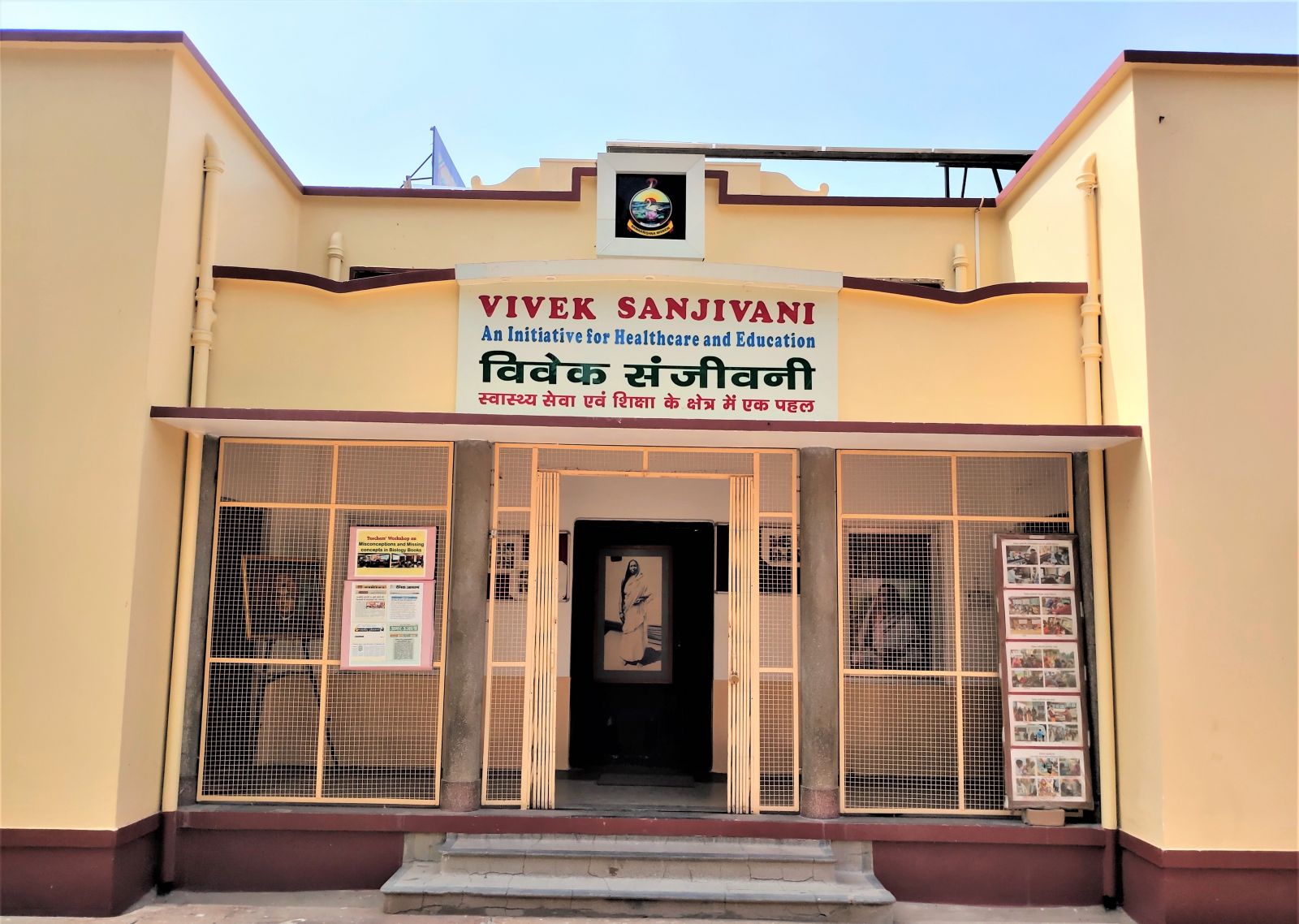
VIVEK SANJIVANI is An Initiative for Healthcare and Education of Ramakrishna Mission Home of Service, Luxa, Varanasi. This department offers Telemedicine services through Eleven Centres in which five Stationary Telemedicine Units (STUs) are fixed at a place and six Mobile Telemedicine Units (MTUs) are roaming. This remarkable initiative bridges the gap between medical expertise and remote communities, transcending geographical boundaries and bringing healthcare to the doorstep of those who need it most. During 2023-24, we served 32,658 patients through our Stationary Telemedicine Units and Mobile Telemedicine Units and conducted Non-communicable Disease Screening (NCDS) for 21,626 patients. Overall, we offered healthcare services to 59,553 beneficiaries which covered five districts including one aspirational district of Eastern Uttar Pradesh and one aspirational district of Uttarakhand.
We extended our healthcare services to beneficiaries among which 54.2% were women and 83.2% were needy and under-privileged people from OBC, SC, and ST communities. NCDS were done for 21,626 New Beneficiaries in which 13,164 were women. Psychiatrist’s consultations for Common Mental Disorder (CMD), Severe Mental Disorder (SMD), Epilepsy patients were done for 7443 in which 3048 were women and 379 were children. From our centres, 417 women received Antenatal care (ANC). Most of the patients saved nearly Rs. 600 to 1000 per visit for Doctor’s consultation, diagnostic tests, and medicine. We tried to propagate Value Education mostly through Audio-visual mode to bring Overall Wellness in life for all the people. We extended Health education through Audio-visual mode to promote healthy living among the rural mass.
Vivek Sanjivani is also engaged in “Shishu Tirth”- A Non-formal Primary Education programme to cater holistic education to 124 kids, Health Education-based and Value education-based film Development, publication of books and research programmes. It conducts Computer classes, online teachers’ training, and teachers’ workshops.
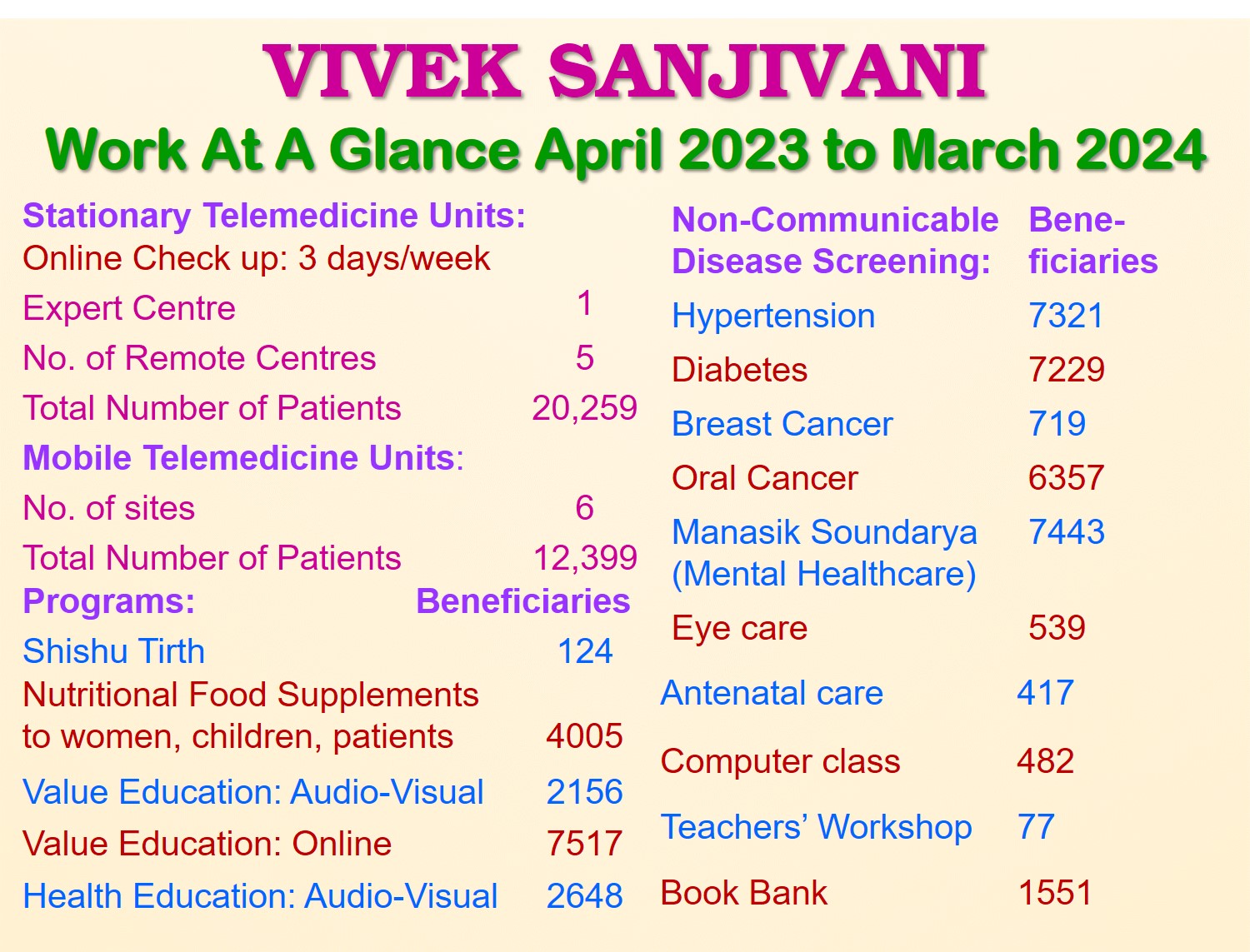
1. Telemedicine Services: Our Real-time telemedicine solutions offer a virtual alternative to the in-person doctor’s visit. It expands access to quality patient care, especially to remote areas and underserved populations that need it the most. It provides a way to cut down on healthcare spending and keep connected patients throughout the year. It is gradually showing the potential to change the healthcare delivery system for the better especially in the rural areas.
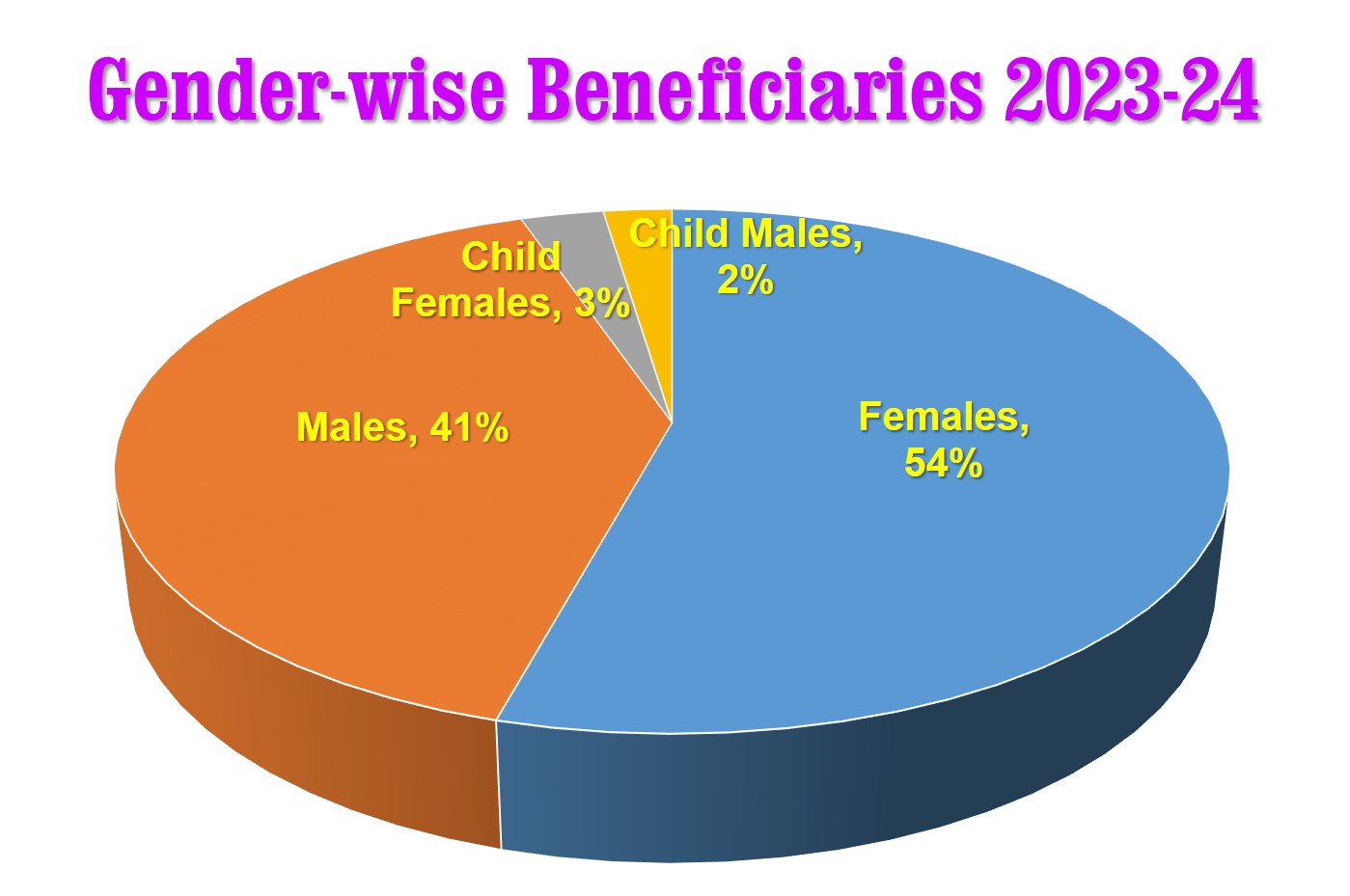
Stationary Telemedicine Units (STUs) of Vivek Sanjivani: Our Telemedicine Units are not merely a collection of wires and screens; it embodies compassion, innovation, and hope. Five Stationary Telemedicine Units (STUs) have been established at different locations viz., Majhawan, Kalwari and Naugawan (district Mirzapur), and Hinauta (district Sonbhadra) of Uttar Pradesh and Bakhpur (district Udham Singh Nagar) of Uttarakhand for providing medical services to the poor, needy and underserved people. Two sub-centres of Bakhpur STU have been started functioning. These centres provide telemedicine services generally three days per week on a regular basis. In our Telemedicine services we use internet communications and Cloud-based Realtime software solutions to provide clinical services to patients without an in-person visit at the Doctor’s chamber.
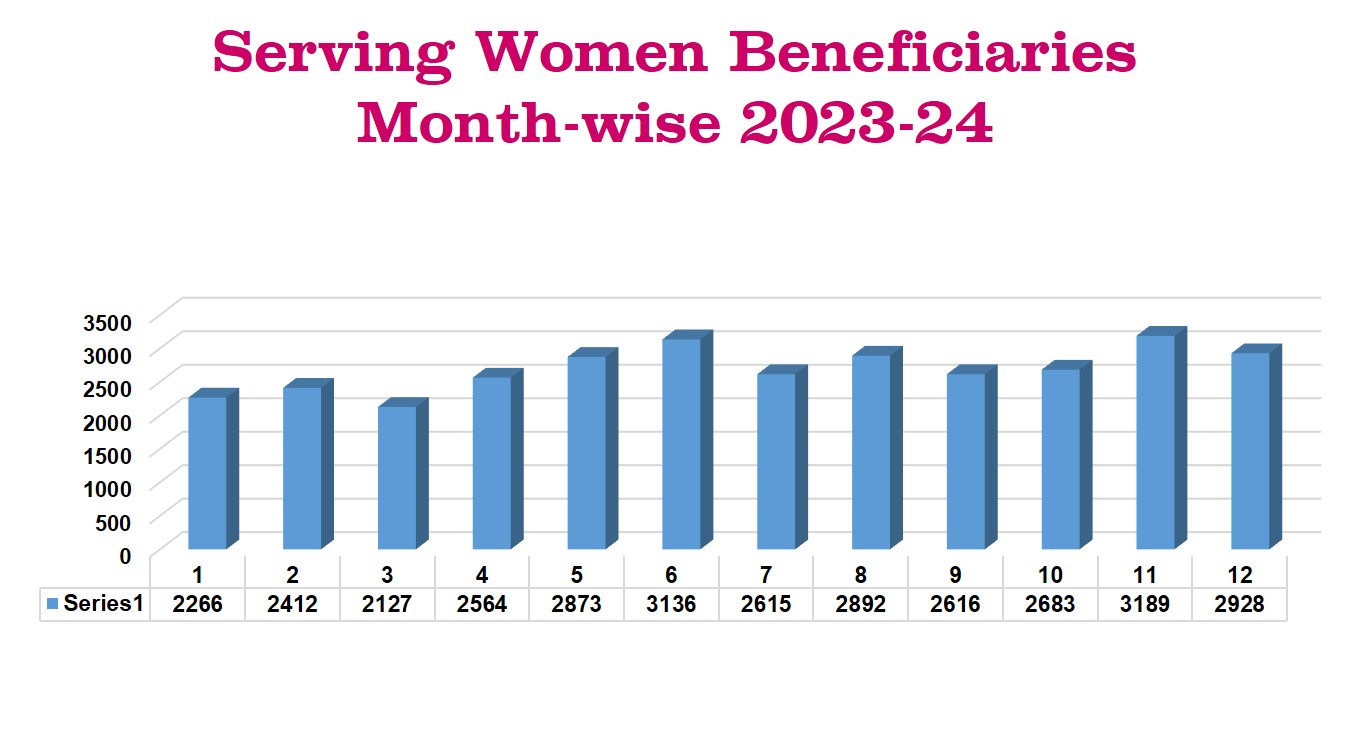
Prefabricated Stationary Telemedicine Unit:
Two Prefabricated Stationary Telemedicine Units have been installed, one at Naugawan, District Mirzapur and one at Hinauta, District Sonbhadra. It is fully powered by Solar Power Backup system. These are supported under Corporate Social Responsibility (CSR) Healthcare Project of Tata AIG General Insurance Co. Ltd. We are thankful to them.
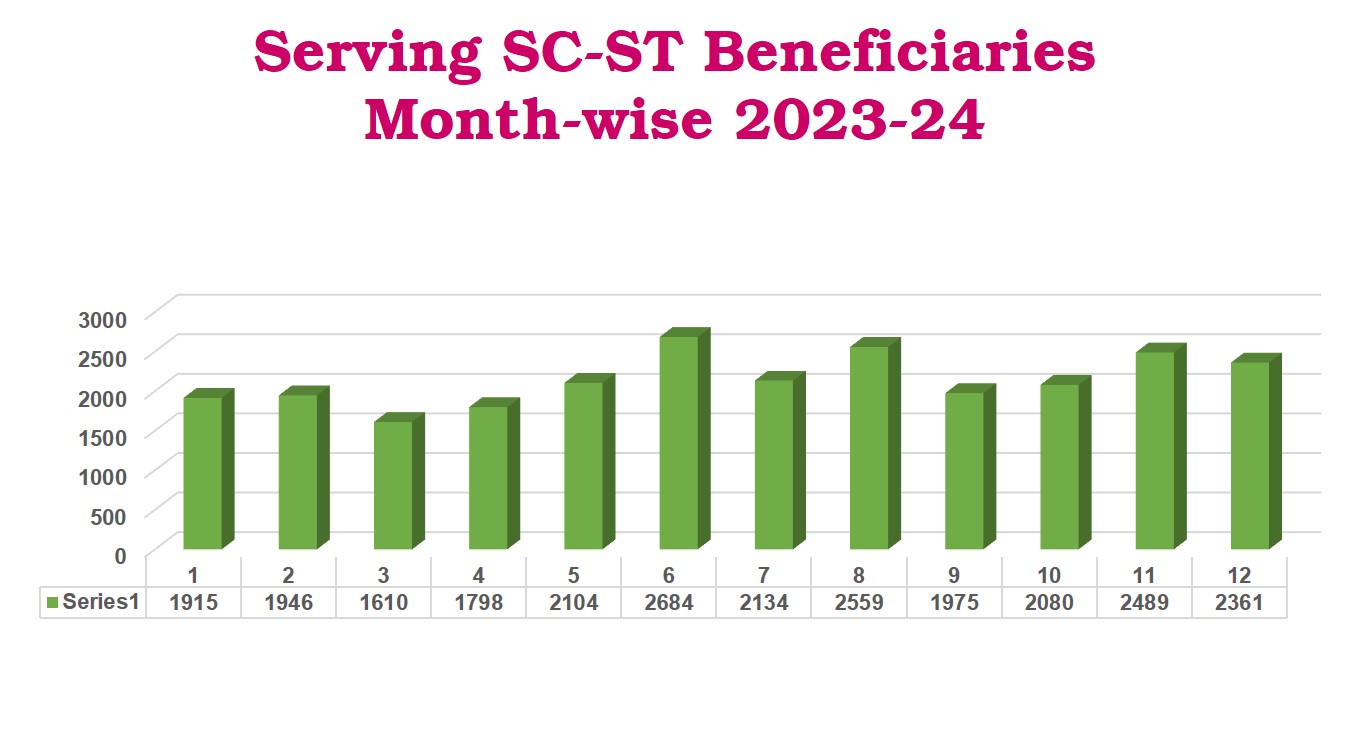
Telemedicine Database Software:
IIT Kharagpur has developed ‘Matri Seva’- a database software, free of cost for keeping patients’ details. The software has been hosted in the Microsoft Cloud-based server to provide easy access to all our centres and doctors.
The physician’s consultations are done from the Hub of Vivek Sanjivani in Varanasi or from the Doctor’s dwelling place. Several Physicians from Kolkata, Anand (Gujarat), Pune and Noida are extending help in treatment of patients. The total number of people treated during April 2023 to March 2024 was 20,259 through STUs. All received free medicine from the remote STUs except in a few cases. Pathological tests like Blood Pressure, Random Blood Sugar (RBS) are done for the patients above 30 years of age. Total number of patients treated in villages through Stationary Telemedicine Units (STUs) during April 2023 to March 2024 is given in a table:
|
Male |
Female |
Child Male |
Child Female |
Total |
OBC |
SC |
ST |
|
|
5 |
8509 |
10312 |
724 |
714 |
20259 |
7474 |
8300 |
430 |
Outcome: 4219 New patients started while 16040 old patients continued to receive telemedicine services in the year 2023-24 from STUs. We extended our Telemedicine services through STUs to patients among which 50.90% were women and 79.98% were needy and under-privileged people from OBC, SC, and ST communities.
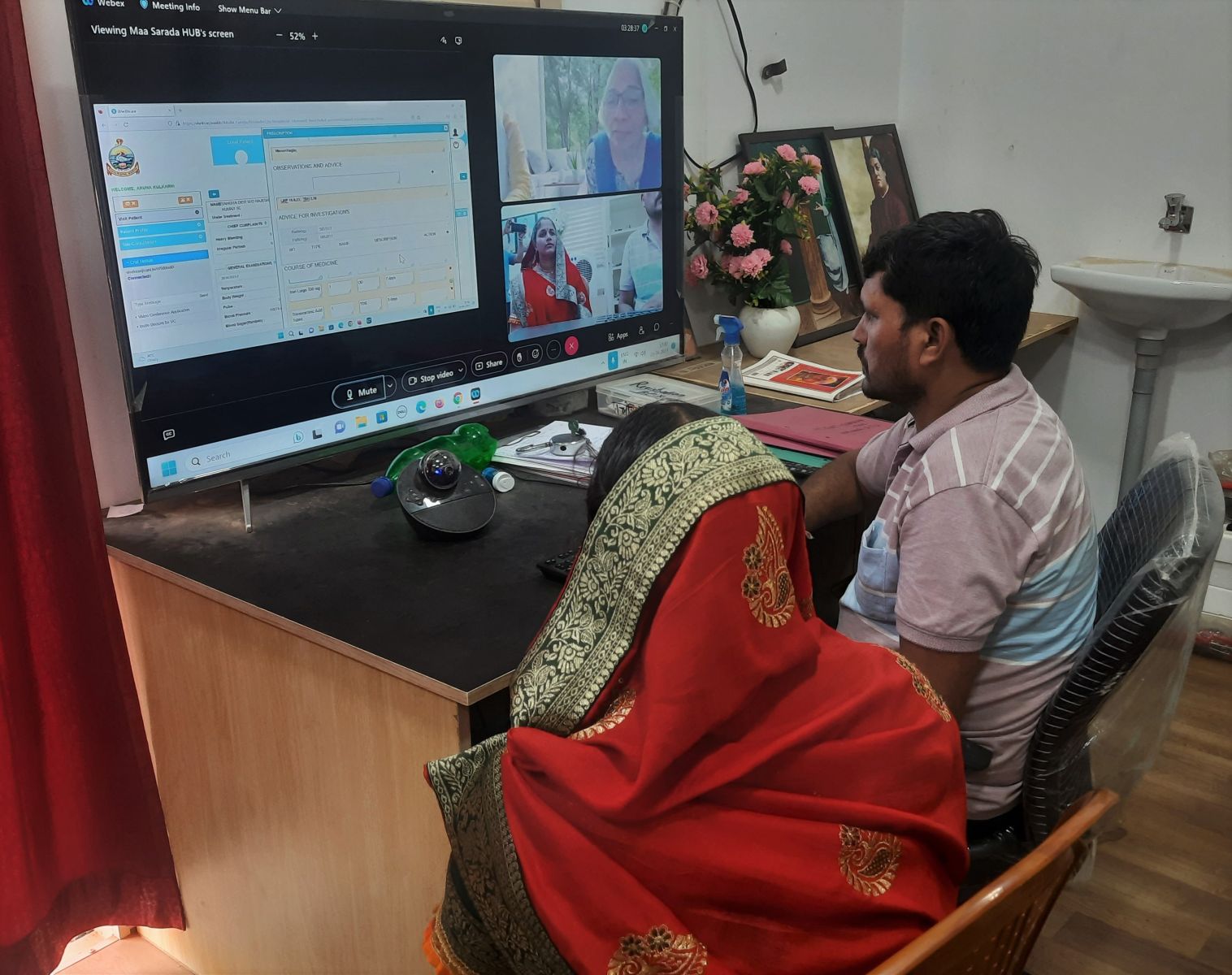
Specialist Services offered through Telemedicine at the door step of village people: Medicine, Psychiatrist, Gynaecologist, ENT, General cum Cardiothoracic, Community Medicine.
Six fundamental benefits from Vivek Sanjivani Telemedicine services:
Consultations with Specialist Physician: Rural people can receive consultations from Physicians including specialists at their door steps through our telemedicine service.
Improved healthcare access through IT-based Services: For the last six years, telemedicine has been used to bring healthcare services to patients in distant locations of Eastern Uttar Pradesh and Uttarakhand. The IT-based telemedicine provide improve access to patients even in remote rural sites.
Cost Efficiencies: Reducing the cost of healthcare is one of the most important reasons for funding and adopting telemedicine technologies. Our Telemedicine has shown reduction in cost of healthcare by Rs 600-1000 per visit for a patient and increased efficiency through better management of chronic diseases, shared health professional staffing, reduced travel times specially for the specialist doctors who can provide treatment from far off places.
Improved Quality Healthcare: Our experiences have consistently shown that the quality of healthcare services delivered via telemedicine are as good as those given in traditional in-person consultations.
Within the reach of Patients: Over the last six years, our study and experiences have shown satisfaction about recovery of the patients through our telemedicine services. The services offered to our patients at the rural areas might not be available to them otherwise at their door steps, and they must travel long distances.
Saving time: Telemedicine service allows physicians to offer their services without travelling to the patients’ dwelling places. Similarly, rural patients need not to travel far off laces for healthcare support. So, Doctors and patients both save time for healthcare services.
Output Analysis: 2023-24:
|
Key Output Indicators |
Unit of measurement |
Target |
|
New Enrolments and follow-up: Through Telemedicine Services, 32,658 patients received consultations with General and Specialist Doctors |
Enrollment and follow up visits. 6368 New patients started while 26290 old patients continued to receive telemedicine services in the year 2023-24. Among the beneficiaries 54.2% were women and 83.2% were needy and under-privileged people from OBC, SC, and ST communities. |
To provide accessible, affordable, and quality healthcare to the rural population, especially the vulnerable groups |
|
Non-Communicable Disease Screening (NCD Screening): It helped to screen patients with chronic diseases |
NCDS of Patients increased. Enabled frontline and middle level Healthcare personnel to have NCD Screening of 21,626 beneficiaries among which 13,164 were women to identify patients with chronic diseases.
|
To offer Services to New Beneficiaries
|
|
Minimizing Digital Divide in Healthcare services in rural areas |
Telemedicine service provided improved access to primary healthcare, care for chronic diseases, mental healthcare, and Epilepsy. 54,284 patients received the benefits of IT-based healthcare services at the rural sites. |
To expand the healthcare services to the remote rural areas with digital support |
Outcome/Impact Analysis: 2023-24:
|
Key Outcome / Impact Indicators |
Unit of measurement |
Target |
|
[I] Quantitative |
||
|
Sustainability |
Sustainability in Telemedicine services to patients. 26,290 old patients continued to receive telemedicine services during 2023-24. |
Sustainability in Telemedicine Services. More than 20000 old patients to be provided healthcare support. |
|
Reduction in out-of-pocket expenses on health |
Most of the patients saved nearly Rs. 600-1000 per visit for Doctor’s consultation, diagnostic tests, and medicine. |
Patients are to pay less for healthcare |
|
More access to Mental healthcare treatments |
Increase in mental health patients’ visit. Doctors’ consultations held for Common Mental Disorders (CMD), Severe Mental Disorders (SMD) and Epilepsy were 7443 in which 3048 were women and 379 were children. |
Better Mental Healthcare Service at rural areas |
|
Provide Antenatal care (ANC) services |
New beneficiaries enrolled. 417 women received ANC. |
Better Mother-child care |
|
[II] Qualitative |
||
|
Key Outcomes / Impacts |
Description |
Goal |
|
Propagation of Value Education |
To inculcate values and practice them in daily life. |
To have Overall Wellness in life |
|
Extend Health education and promote a healthy lifestyle |
To encourage to adopt good habits. |
Healthy living |
2. Mobile Telemedicine Units (MTUs): Health on Wheels:
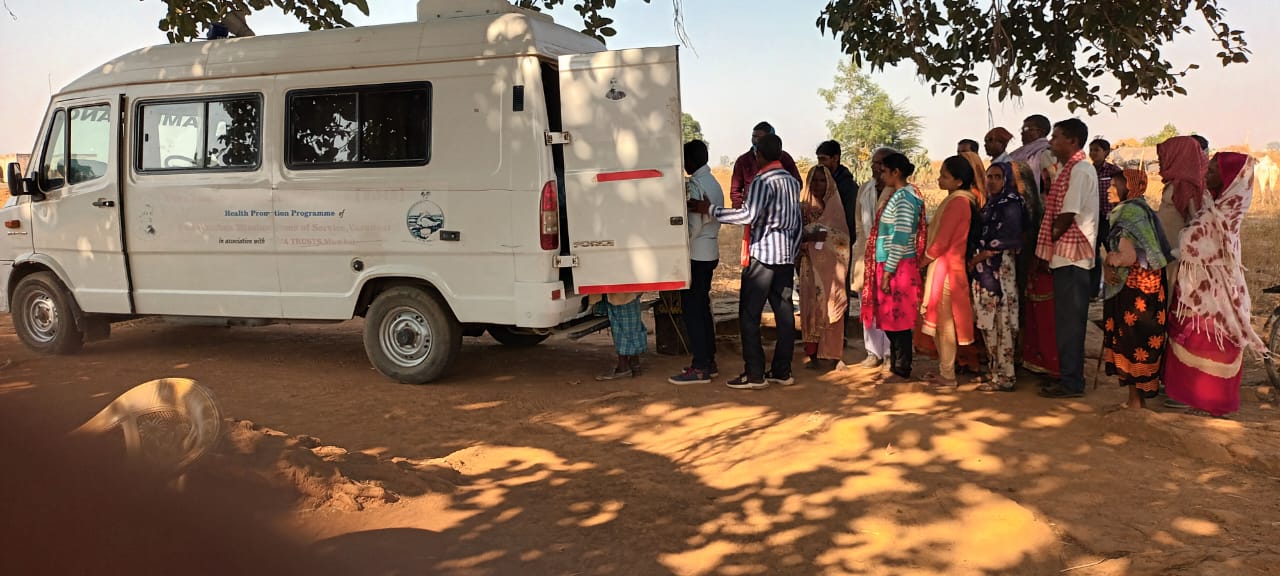
In rural Uttar Pradesh nearly 60 percent of the total rural population lives below the poverty line. Our Mobile Six Telemedicine Units are located at Gaura, Manikpur, Patewar, Ramnagar (Devahin), Kanaksarai, Deepnagar in District Mirzapur, U.P. These units offer flexible and viable options to offer healthcare facilities to the vulnerable groups. Our Mobile Telemedicine Units (MTUs) help to conduct screenings, basic diagnosis and provide primary healthcare services to complex medical treatments closer to people’s homes.
Total number of patients treated in villages through Mobile Telemedicine Units (MTUs) during April 2023 to March 2024 is given in a table:
|
MTUs |
Male |
Female |
Child Male |
Child Female |
Total |
OBC |
SC |
ST |
|
6 |
5844 |
5850 |
281 |
424 |
12399 |
5493 |
3863 |
977 |
3. Non-Communicable Disease Screening (NCDS):
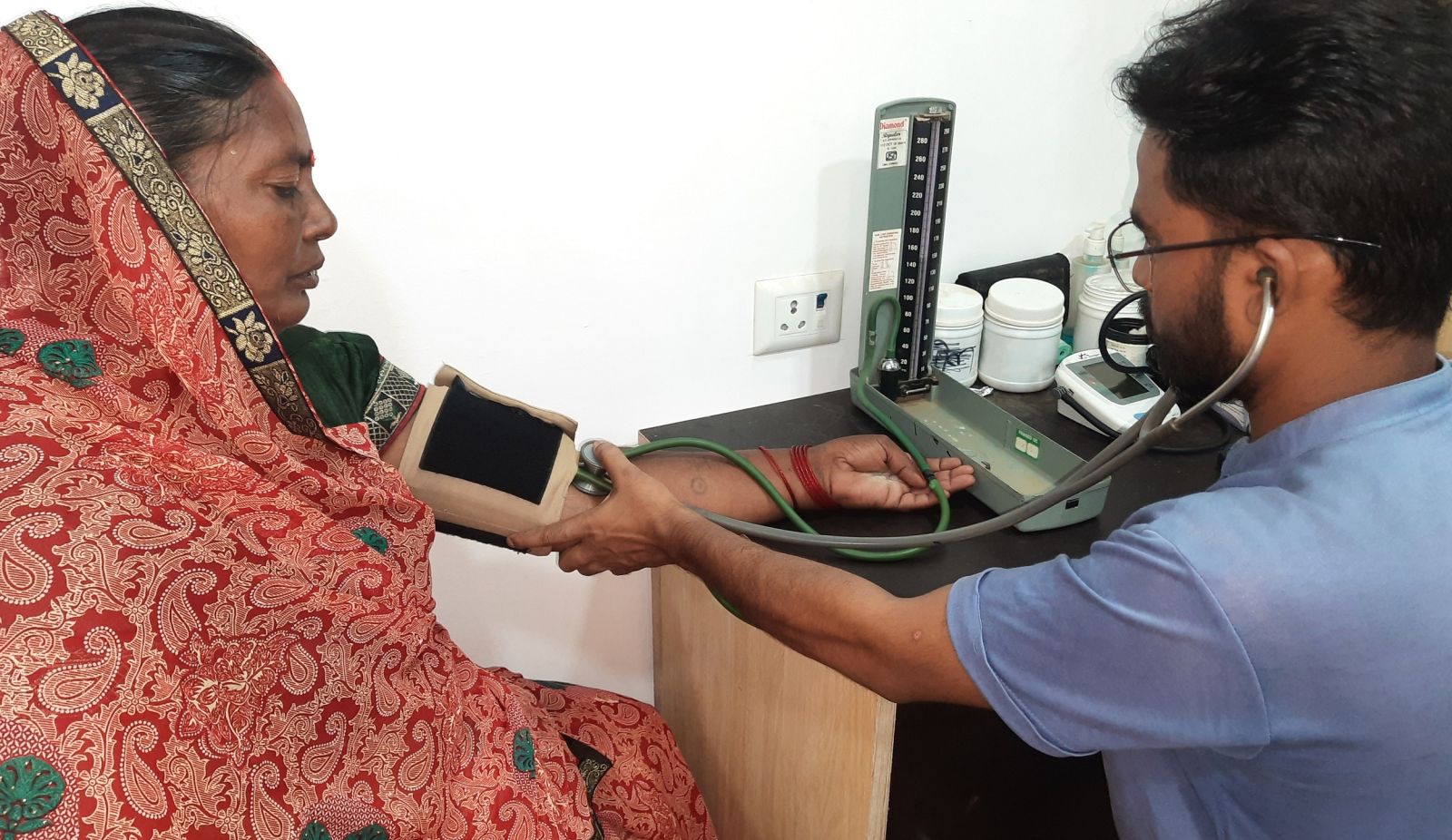
Screening done for Hypertension (HTN), Diabetes (DM), Oral Cancer (OCE), and Breast Cancer (BCE) among the target age group of 30 years and above through Stationary Telemedicine Units (STUs) and Mobile Telemedicine Units (MTUs) on the first day of the registration of the patient and some cases NCDS were done in the villages. Below are the details of screenings done during April 2023 to March 2024:
|
Types of NCDS |
Hypertension |
Diabetes |
Breast Cancer |
Oral Cancer |
Total |
|
No. NCD Screening |
7321 |
7229 |
719 |
6357 |
21626 |
4. Mansik Soundarya (मानसिक सौंदर्य) (Community Mental Health Program):
The community Mental Health Programme is devoted to the evaluation and improvement of public mental health of poor people affected by mental disorders, emotional disturbances, and/or addictions. The patients from Patewar, Kalwari, Naugawan, Hinauta, Majhawan, Manikpur, Ramnagar, Gaura, Kanaksarai and Deepnagar of U.P. and Bakhpur of Uttarakhand are receiving 3 tiered comprehensive psychiatric and neurological treatment for (i) Common Mental Disorders like Depression, Anxiety, Obsessive Compulsive Disorder (OCD) (ii) Severe Mental Disorders including Psychosis, Bipolar Disorder, Schizophrenia and Major Depression and (iii) Epilepsy. During 2023-24, we offered treatments to 7443 mental health and neurological patients among which 2511 OBC, 3118 SC and 531 ST patients were served. A tabular representation is added for better understanding:
Common Mental Disorders (CMD): Visit-wise
|
Units |
CMD |
|
|
|
||||
|
|
Male |
Female |
Child Male |
Child Female |
Total |
OBC |
SC |
ST |
|
STU |
246 |
427 |
1 |
2 |
676 |
288 |
222 |
31 |
|
MTU |
129 |
454 |
0 |
1 |
584 |
231 |
162 |
10 |
|
Total |
375 |
881 |
1 |
3 |
1260 |
519 |
384 |
41 |
Severe Mental Disorders (SMD): Visit-wise
|
Units |
SMD |
|
|
|
||||
|
|
Male |
Female |
Child Male |
Child Female |
Total |
OBC |
SC |
ST |
|
STU |
1179 |
683 |
36 |
17 |
1915 |
544 |
846 |
60 |
|
MTU |
1063 |
458 |
0 |
3 |
1524 |
631 |
706 |
75 |
|
Total |
2242 |
1141 |
36 |
20 |
3439 |
1175 |
1552 |
135 |
Epilepsy (EPI): Visit-wise
|
Units |
EPI |
|
|
|
||||
|
|
Male |
Female |
Child Male |
Child Female |
Total |
OBC |
SC |
ST |
|
STU |
605 |
430 |
84 |
63 |
1182 |
330 |
565 |
52 |
|
MTU |
794 |
596 |
33 |
139 |
1562 |
487 |
617 |
303 |
|
Total |
1399 |
1026 |
117 |
202 |
2744 |
817 |
1182 |
355 |
Common Mental Disorders (CMD): Unique Patient Health Status
-%20Unique%20Patient%20Health%20Status.jpg)
Severe Mental Disorders (SMD): Unique Patient Health Status
-%20Unique%20Patient%20Health%20Status%20.jpg)
Epilepsy (EPI): Unique Patient Health Status
-%20Unique%20Patient%20Health%20Status.jpg)
5. Eye care:
Cataract and refractive errors are two major public health problems in the context of ocular health in developing countries like India. Currently, India is the second highest country next to China in contributing to the total burden of world blindness. Cataract is the most common cause of blindness (62.4%) followed by uncorrected refractive error (16.65%). Of this total burden of blindness more than eighty five percent of them are preventable if appropriate eye care services are provided.
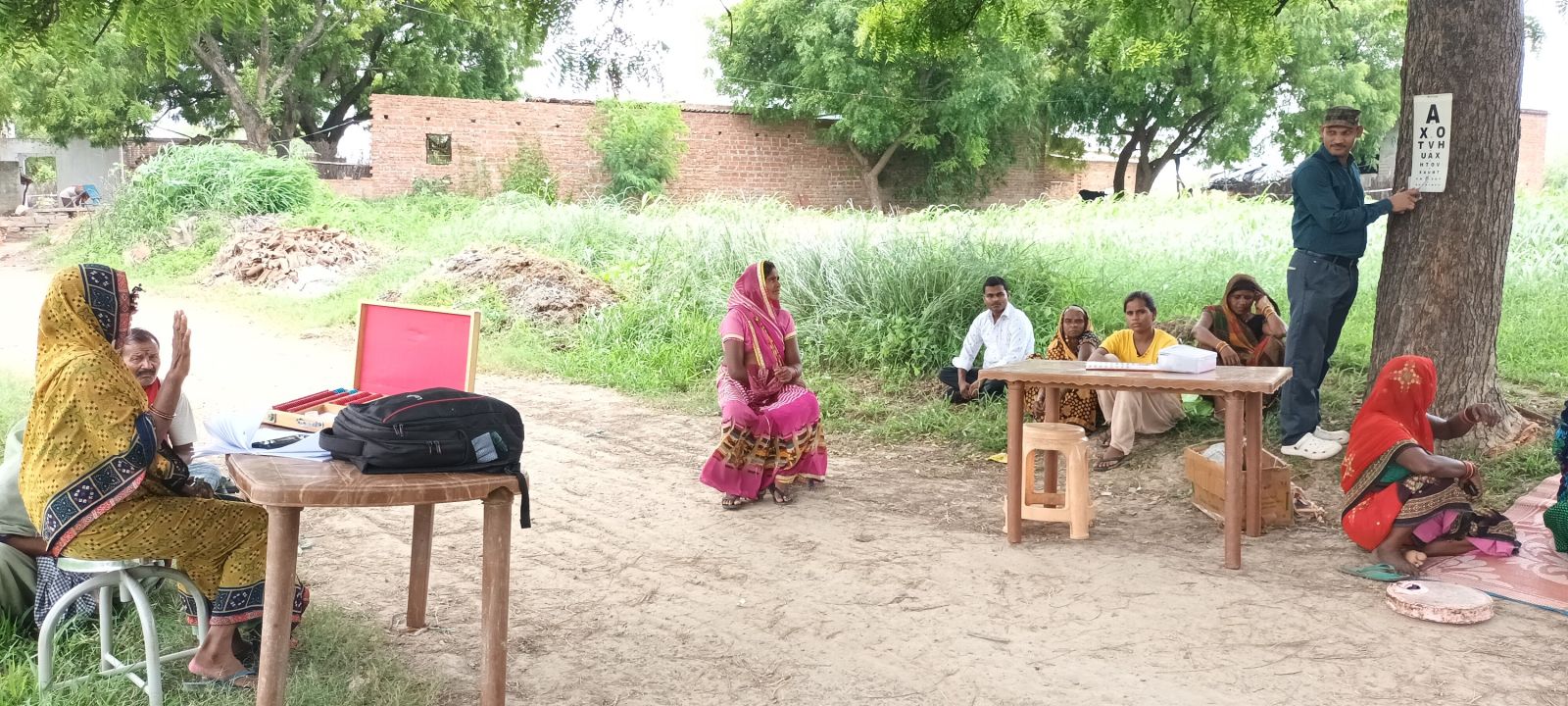
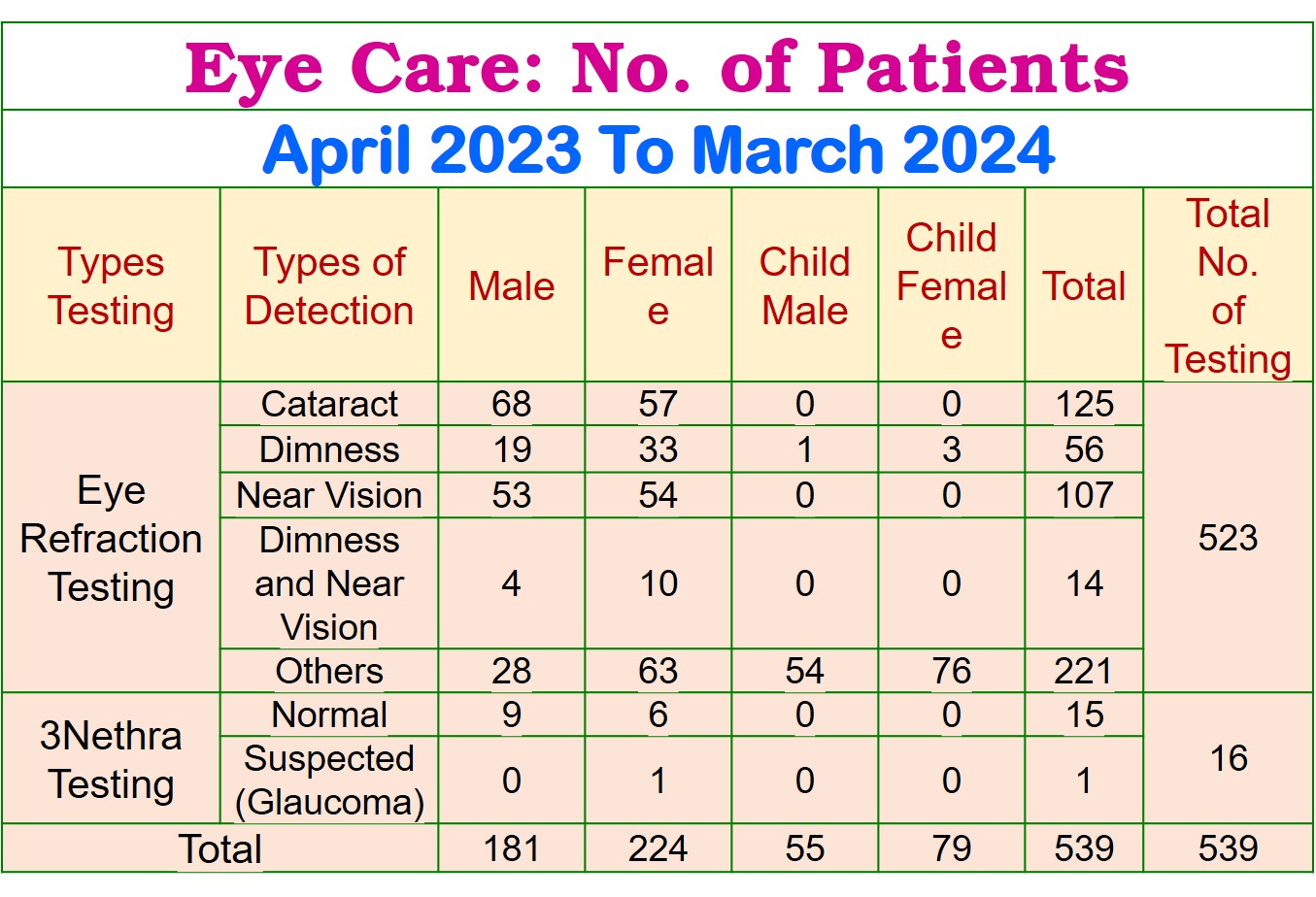
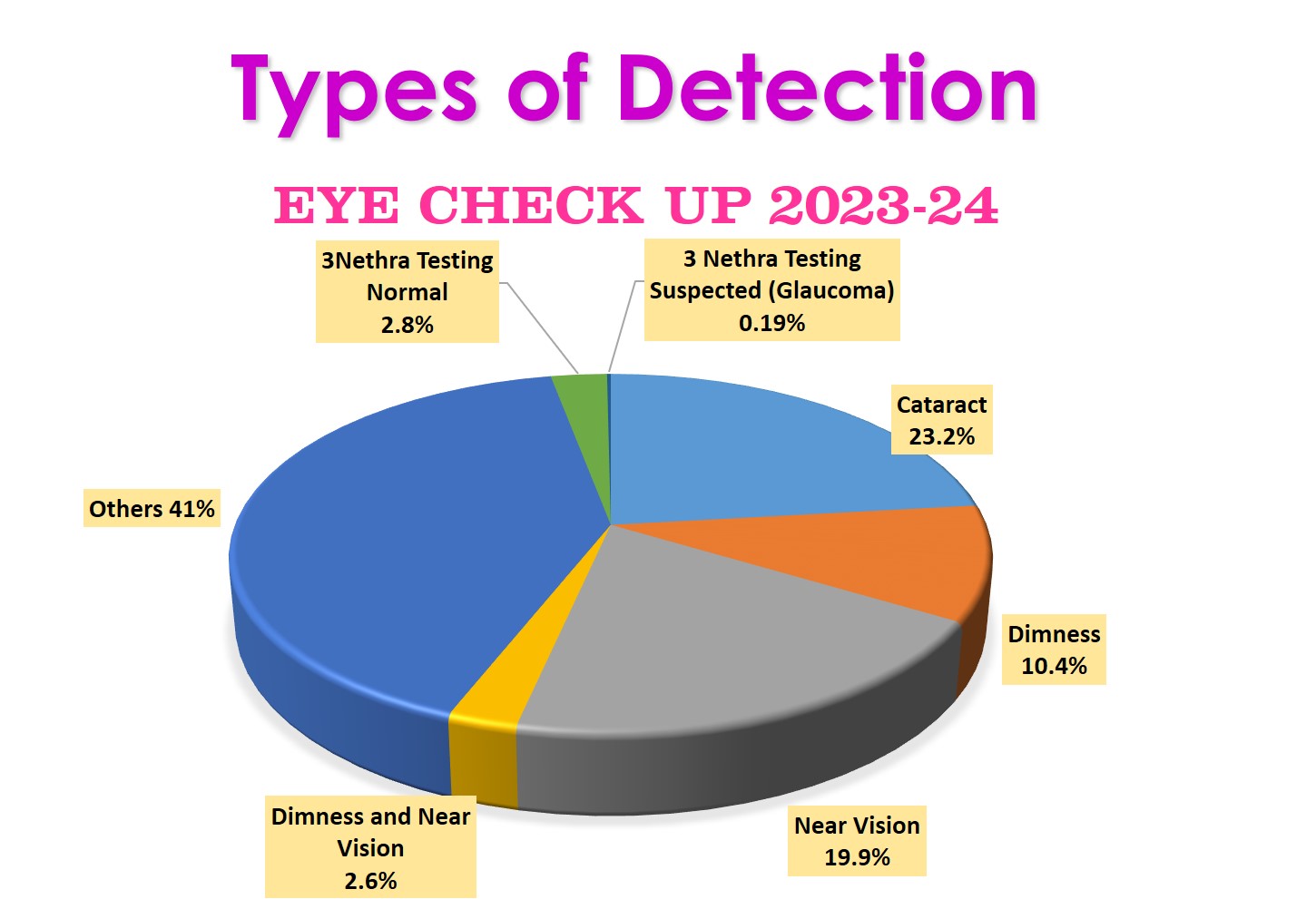
|
Eye Refraction Testing |
|||
|
Sr |
Group |
Age Span |
No. of |
|
1 |
Kishor |
5 - 16 yrs. |
134 |
|
2 |
Young |
17 - 29 yrs. |
36 |
|
3 |
Adult |
30 - 60 yrs. |
243 |
|
4 |
Old |
61 - 70 yrs. |
88 |
|
5 |
Old Senior |
>70 yrs. |
22 |
|
|
|
Total |
523 |
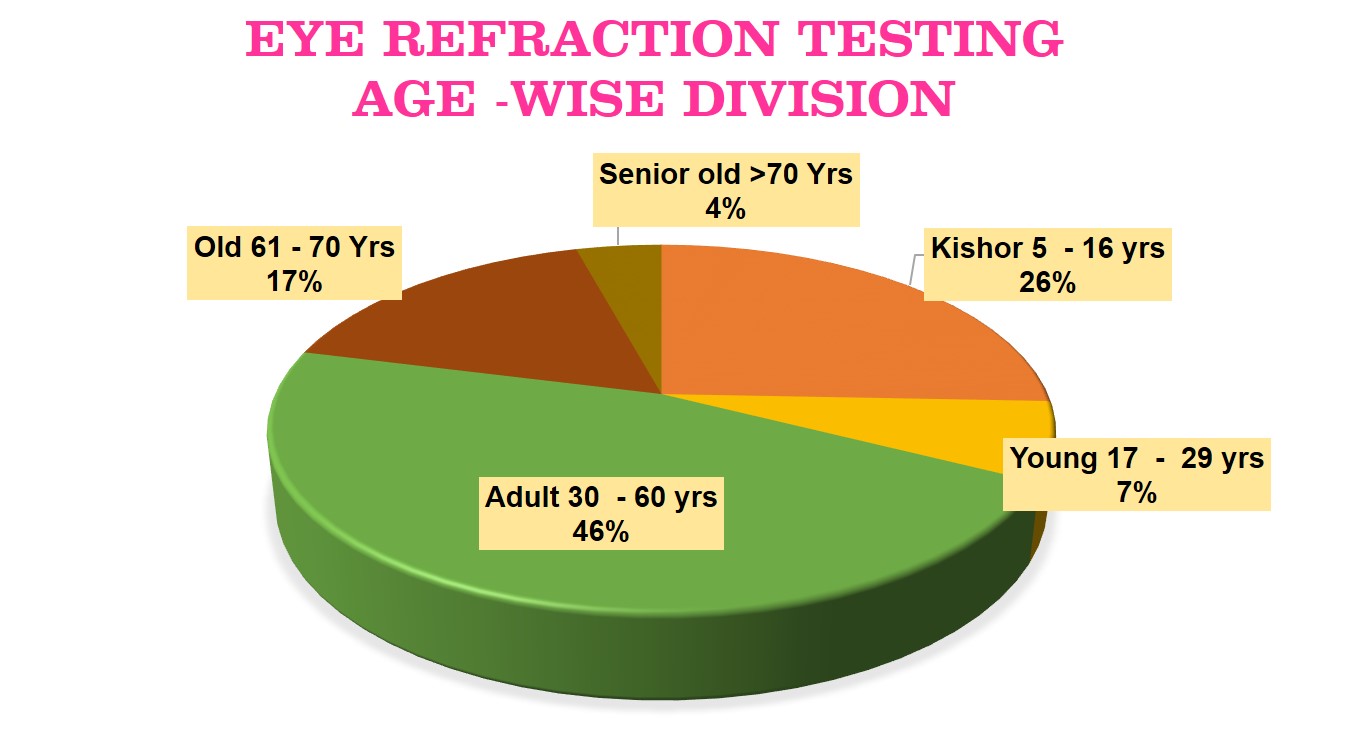
6. General Movement Assessment in Neonates and infants for Early intervention, family Support and Health awareness (G.A.N.E.S.H.)
The unique feature of this project is General Movement Assessment of children especially up to 5 months of age. In this year a total of 47 GMA Screening took place. Prof. Christa Einspieler of Austria is providing the special training and guidance to our Healthcare workers.
7. Distribution of Nutritional Food Supplements
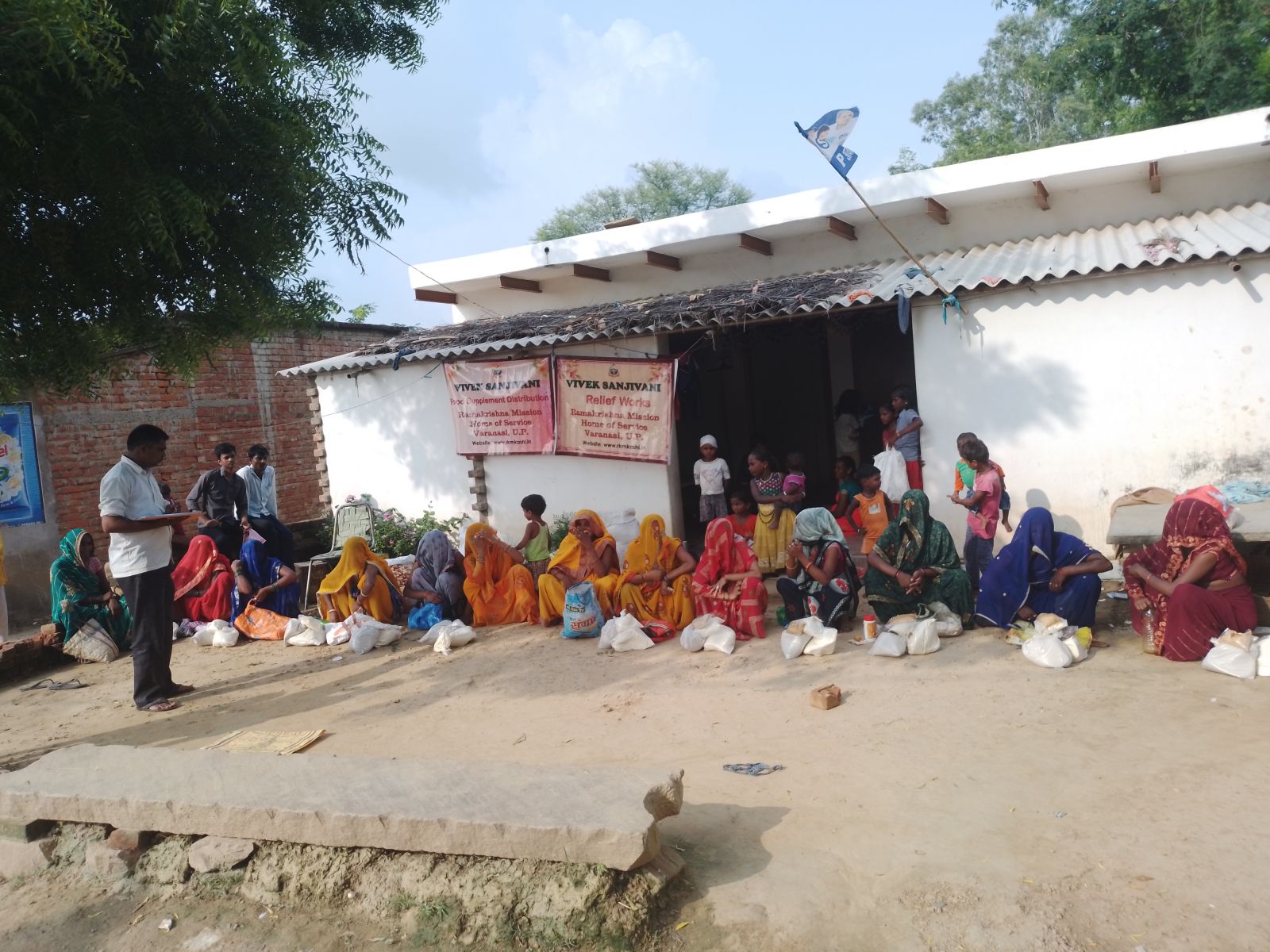
Distribution of Nutritional Food Supplements are continuing uninterrupted till date. Nutritional food supplement items (Kaju, Bajra, Soyabean, Besan, Ground Nut, Jaggery and Mustard Oil) are regularly being distributed monthly to on an average 293 poor, pregnant, lactating mothers, and malnourished children 171 Chronic patients,124 Shishu Tirth Students of villages Mirzapur and Sonbhadra districts which provide 750 kcal/day and 37g of additional proteins every day to each woman and child.
|
|
Pregnant and Lactating Mother |
Malnourished Child under age 5 yrs. |
DM & HTN Patients |
Shishu Tirth |
Total Beneficiaries |
|
No. of Beneficiaries |
1329 |
32 |
1844 |
800 |
4005 |
8. Promotion of Health Education
The purpose of our Health education is to positively influence the health behaviour of individuals and communities as well as the living and working conditions that influence their health and empower them to lead healthy lives. Health education activities should enhance the overall goal of the health promotion and disease prevention program. It can trigger far-reaching health improvements in serving vulnerable groups. Films are developed for health education programs which are culturally appropriate and tailored for the rural populations to ensure acceptance of the messages. In developing films, we are addressing cultural and linguistic differences, potential barriers to health promotion and disease prevention in rural areas to increase control over and improve their health through attitudinal, behavioural, social, and environmental changes.
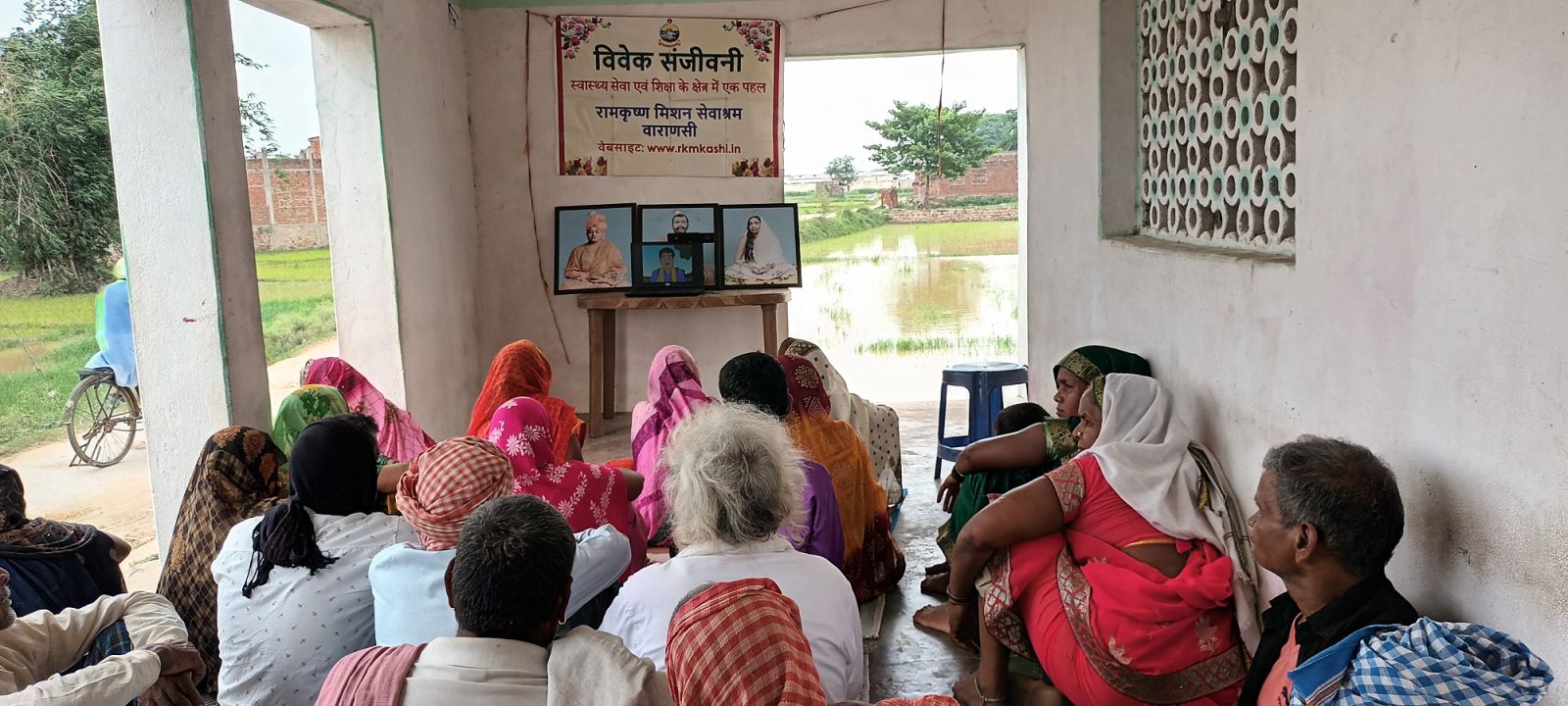
Films based on Health education developed by our department were screened in different areas, which were viewed by villagers including students during 2023-24:
|
S.N. |
Health Education Topics |
Session |
Male |
Female |
Child Male |
Child Female |
Total |
|
1 |
Acute Respiratory Infection |
7 |
85 |
61 |
37 |
41 |
224 |
|
2 |
Amulya Jivan |
4 |
47 |
32 |
32 |
36 |
147 |
|
3 |
Child Health Care 0 to 5 yrs |
1 |
5 |
25 |
0 |
0 |
30 |
|
4 |
Control Diarrhoea (DD) |
6 |
81 |
107 |
17 |
14 |
219 |
|
5 |
Dental Care (Dental) |
5 |
72 |
36 |
0 |
1 |
109 |
|
6 |
DM and HTN |
3 |
36 |
33 |
18 |
9 |
96 |
|
7 |
Food for Health (FFH) |
5 |
50 |
94 |
10 |
21 |
175 |
|
8 |
Hygiene & Sanitation |
1 |
0 |
0 |
11 |
0 |
11 |
|
9 |
Nishabd Ghatak |
8 |
82 |
83 |
9 |
8 |
182 |
|
10 |
Non-Nutritional Child Health 0-3 |
5 |
80 |
73 |
13 |
12 |
178 |
|
11 |
Non-Nutritional Child Health 3-10 |
3 |
43 |
55 |
3 |
6 |
107 |
|
12 |
Roll Back Malaria |
6 |
77 |
84 |
16 |
14 |
191 |
|
13 |
Schizophrenia |
5 |
51 |
45 |
3 |
2 |
101 |
|
14 |
Stop Tuberculosis (TB) |
5 |
59 |
68 |
3 |
8 |
138 |
|
15 |
Tobacco Use Prevention (TUP) |
5 |
69 |
63 |
1 |
6 |
139 |
|
16 |
Women Health (Menstrual Health) |
6 |
74 |
87 |
6 |
3 |
170 |
|
17 |
Women Health- Mala (ANC) |
9 |
161 |
151 |
6 |
18 |
336 |
|
18 |
Women Health (Gender) |
3 |
46 |
48 |
1 |
0 |
95 |
|
Total |
87 |
1118 |
1145 |
186 |
199 |
2648 |
9. Antenatal Care: Total number of Antenatal Care (ANC) given to 417 in 7 villages. We provided minimum five check-ups in respect to Ante-Natal Care, two Tetanus Toxoid injections, iron tablets with folic acid, calcium tablets, training regarding nursing of infants etc.
10. Gynecare: Our trained women Health Educators and Assistant Health Educators provided 695 women with gynaecological examination and subsequent treatments offered by the doctors.
11. Tuberculosis Patients: These patients received free medicine and other Govt. benefits from our department.
|
Male |
Female |
Child Male |
Child Female |
Total Patients |
OBC |
SC |
|
50 |
74 |
2 |
10 |
136 |
56 |
32 |




